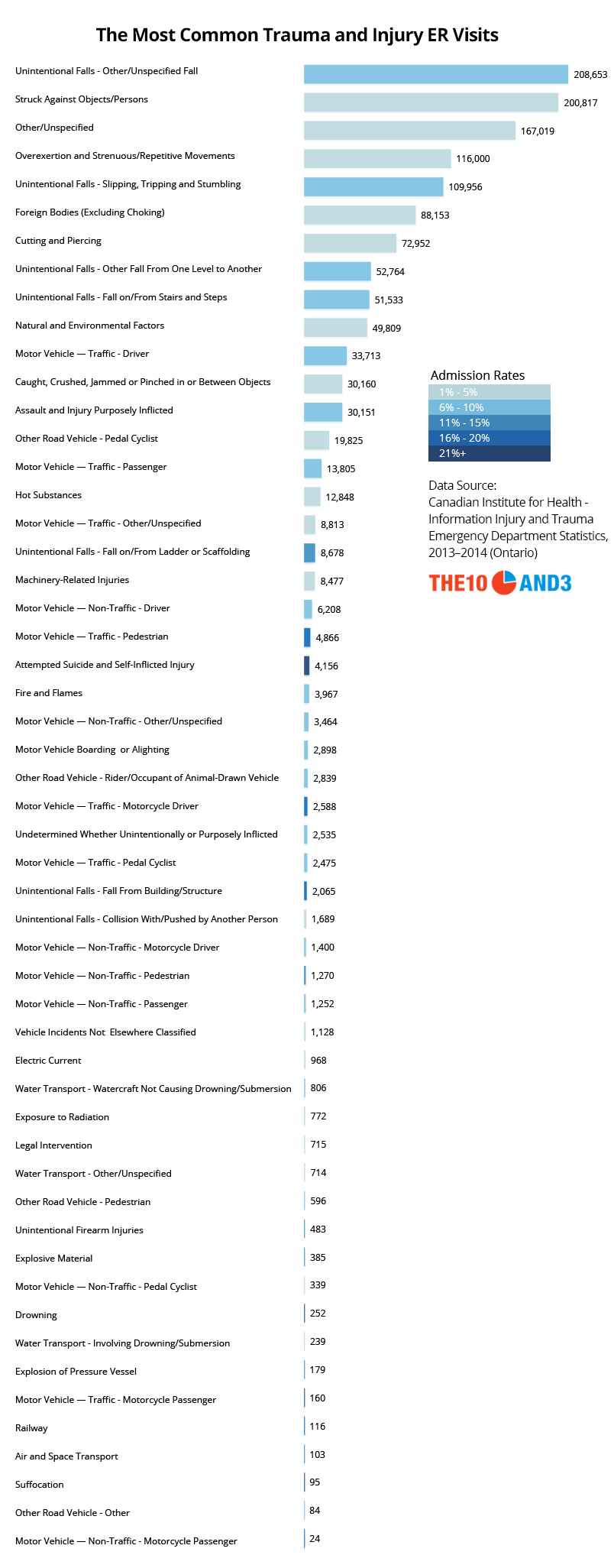With ERs in cities across the country facing unacceptably high wait times, we were curious what sorts of visits are causing all of the congestion in these critical facilities. Is the rise in concussions and brain injuries among children to blame for the overcrowding, or are simple cuts and scratches unnecessarily packing ERs with many folks who could otherwise be treated at home?
We turned to the Canadian Institute for Health Information, which classifies injury and trauma ER visits (though not visits for infectious ailments like the flu) to emergency rooms across the country, to help us understand. As we’ve noted in past studies on the state of healthcare in Canada, data collection in this country is extremely uneven, and typically missing for vast swaths of the population, including entire regions and even provinces. There was no difference this time around. Fortunately, the country’s most populous province, Ontario, maintains excellent data reporting for injury and trauma visits across its entire network of emergency rooms, so we focus here exclusively on Ontario’s statistics.

Perhaps unsurprisingly, falls comprise the largest single cause of injury and trauma ER visits across Ontario hospitals (over 200,000 in a year). This broad category includes injuries due to falls suffered on the ice and snow, on the playground, or from beds, chairs and other areas of the home.
The second largest category, comprising another 200,000 annual ER visits in Ontario, involves injuries due to being struck by objects — typically in the context of sports activities or contact with broken glass and other household accidents — or being struck by people — again, typically in the context of sports activities. Finally, another large chunk of visits (116,000) comes from overexertion, which includes injuries due to heavy lifting or other strenuous physical activity.
While such injuries can indeed be serious, hospital admission rates due to these largest categories are relatively modest, at well under 10%. Several other types of visits, which each contributed only a few hundred ER visits in Ontario, resulted in much more serious rates of admission: suffocation (44%), injuries to motorcycle passengers (26%), drowning (20%) and injuries to motorcycle drivers (18%).
Finally, a few particularly notable categories also stand out. Injuries resulting from legal intervention resulted in over 700 annual visits to Ontario ERs; these are injuries inflicted by police or other law enforcement in the course of arrests, maintaining order or other legal actions.
Another 485 annual visits were due to the unintentional discharge of firearms, 15% of which were serious enough to warrant hospital admission.
Methodology
The CIHI data includes only ER visits classified as being an injury or trauma in this analysis, covering the time period April 1 2013 through March 31 2014. While the CIHI does collect some data for several provinces, only the data for Alberta and Ontario include all emergency facilities within those provinces; for simplicity, we’ve chosen to present data only for Ontario. We note that there is no reason a priori to suggest that the trends across the entire country should be meaningfully different than those in Ontario. This document provides details on the classification definitions used by the CIHI.
Don’t miss our newest stories! Follow The 10 and 3 on Facebook or Twitter for the latest made-in-Canada maps and visualizations
